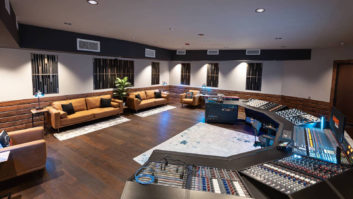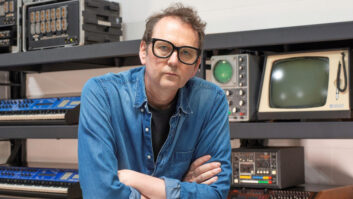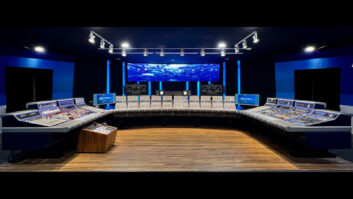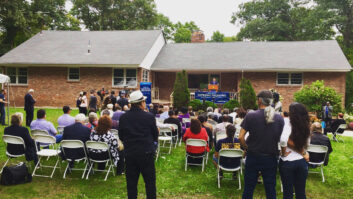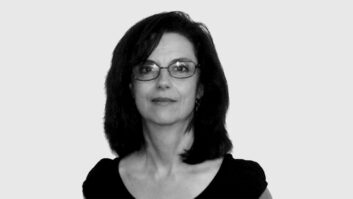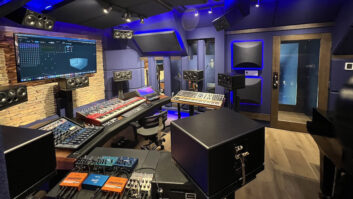John Storyk has been a fixture in studio design almost since there were studios to design. At 53, he can trace his professional lineage back to the days when recording studios began evolving from utilitarian boxes into actual musical instruments, a time when the term “design” began to precede the word “build” when it came to places in which people made serious sounds.
Storyk’s professional career began in 1969, the year of Woodstock-which both he and this writer attended-and the year in which the music business crossed a line from cottage industry to mega-industry. A native of Long Island, Storyk had attended Princeton University and played in the marching band and in weekend rock bands as a keyboardist and saxophonist while studying architecture. The convergence of those two passions is now imprinted on over 650 facilities of various types, from recording studios to post facilities to corporate board rooms.
Storyk lives in a small town near Poughkeepsie, N.Y., with his wife and partner of eight years, Beth Walters, and their two children. Walters, whom Storyk describes as “my partner in every way imaginable,” is an F.I.T. graduate who specialized in fabric design and whose interior design aesthetic creates a synergy with Storyk’s command of time, space and physics. Numerous projects are currently under way at the Walters-Storyk Design Group (WSDG), including a third studio at New York’s Sound On Sound as well as studios in Europe and South America. (WSDG opened associate offices in Basel, Switzerland, and Buenos Aires, Argentina, last year, and Storyk supervises an increasingly global domain that has stretched from Reykjavik to Kuala Lumpur via e-mail and video conferencing.) As a result, Storyk suffers from the same sort of syndrome that any harried executive in the ’90s does, when jet lag can manifest itself without one ever having stepped onto a plane.
Storyk’s long relationship with studios goes back to some of the seminal facilities in rock ‘n’ roll, including two of the most famous: Jimi Hendrix’s Electric Lady Studios and Albert Grossman’s Bearsville, two facilities for which he has a special fondness-particularly the latter, which was originally conceived as a studio for Grossman’s record label of the same name. Storyk sketched out the basic design for the first room at Bearsville on a cocktail napkin, and Grossman ended up giving Storyk office space for over a decade as Storyk built his business. (Grossman, who is buried near the studio, also managed Bob Dylan. “He invented artist management as we know the term today,” Storyk observes of his mentor.)
Today Storyk’s studio design firm is headquartered about 30 miles away on the east bank of the Hudson River. Cocktail napkins have given way to TEF analyzers and CAD programs. But despite all the changes in the technology and the business, Storyk maintains that the essence of designing for sound still comes down to the space between the speakers and the human being.
How did you get into this business?
I had those two loves, music and architecture. I came out of school, and in the summer of ’68, due to some strange and accidental events, I found myself designing and actually building a very small club in SoHo-this was before the word “SoHo” existed-called Cerebrum. It was tiny and had a life of only nine months. This club was one of the new hot spots in town along with Dionysus and Electric Circus. All of a sudden at the age of 23 we’re in Life and Time magazines. Then one night Jimi Hendrix and his manager, Michael Jefferies, come in. They had decided to buy a club on Eighth Street in the basement of a theater. Jimi was playing there so much and running up such a tab that they just decided to buy the club. Jimi turns to Michael and says why don’t we get the guy who designed that club? I got a call the next day from Jefferies to design the club. I had a meeting with both of them and started designing a club, Electric Ladyland. At the last minute, the club gets scrapped due to the efforts of Eddie Kramer, who produced and engineered Jimi’s records. The next thing you know, I’m designing a studio. I took two months off my job and took a crash course in the world of studio design, which in 1968 was not a particularly big world, and started designing and building Electric Lady, which opened a year later.
Electric Lady is an amazing place that’s perhaps as well known for the Minneta River as for the records that got made there.
The studio is on top of a river, like a high flood table now, which ran through the Village. To get the isolation in the B studio, the only way we could do it as the ceiling sloped down was to build sloped walls to support the isolation system. To do that we had to dig down for the footings. But one day we went down one shovelful too much. The next thing you know we had Old Faithful in the basement. We covered it up and shifted the design from a heavy black wall solution to a lighter drywall solution and installed on a permanent basis two water pumping systems, one to back up the other. Several times over the years both pumps have failed and they have had water in there.
A more common urban problem would be something like a subway. How has design changed to accommodate urban noise over the years?
In the most general sense, not much has changed fundamentally.
You still measure the bothering noise, which in this case was the community environment. Electric Lady had two real bothersome neighbors-one was the theater above and the other was the subway about 100 yards away. Today, it’s the same process: You measure how much they bother you by. What has changed is that studios have to be quieter than they were 30 years ago because of digital recording. But the process is the same. If I had that same studio to do over again, I wouldn’t [approach the noise problem] differently. We did not design for the subway. We decided it was impossible to completely eliminate the subway noise. There wasn’t enough height to build practical isolation. So once every ten minutes there’s a tiny little rumble in there. They just accept it. It’s been going on for 30 years.
You did Blue Rock and other new studios around that same time. This was a kind of new age of independent studios.
That’s exactly right. Like I said, when I went around to learn about studios, it was not a particularly big universe.
So you caught a wave. Your entry into the design business coincided with the rise of new studios to feed the growing rock monster.
I would be the first to admit that. The 1966 to 1975 period was exactly that. People ask me how they get started in the studio design business, but I’m 53; what I did has little to do with what you’d do now. It was a totally different time. People were okay with experimenting. People accepted studios whose equipment was much better than the [studio] environments, and that’s because in 1969 the entire studio world was totally driven by equipment. Since then, there’s been an entire world of literature and people discussing what can be done. You had more opportunity to be wrong and more opportunity to be right. You could experiment and sometimes hit the nail on the head. It was more fun. Now, the level of expectation is extremely high. People bring you on, and if you make 980 of 1,000 little decisions right, you get fired. If you make 990 right, you get a “thank you.”
Bearsville was one of the first project studios, really, dedicated to one company’s or person’s projects.
I met Albert in 1969 not because of Electric Lady, though Michael Jefferies lived about a quarter-mile away from him in Woodstock. I met Albert because the guy who was the line manager for The Band, John Taplin (who went on to become a successful Hollywood producer), and I were friends from Princeton. He was working with Albert, and when he found out that Albert wanted a studio, he introduced me. The original intent was to be an in-house recording studio. I don’t think Albert ever thought it would become a money-making studio, much less the only thing left of his empire. His real interest was management and publishing. The studio was an adjunct. Within about 18 months, as that studio got built, we became friends, and I came back and did more projects for him. After I came back from Colorado in 1974, I wanted a weekend place in Woodstock and Albert offered me a space on his estate. That started a relationship that lasted 15 years.
The whole building was built as a block building, but Studio B was outfitted first, with a Ted Rothstein Quad 8 console; Studio A was like a rehearsal studio and had no equipment. The Band kind of parked themselves there for a while. There was a time when Albert was the largest builder in Woodstock, and only building for himself.
Studio B has a lot of history, from The Band to Peter Tosh to Van Morrison. What made it so special?
At the time there was no destination recording studio that was like a resort. The only one like it really was James Guercio’s Caribou Ranch in Colorado. The location made it special. The rooms were very bright, though. It was definitely conceived as a place where a group could park and make it feel like a rehearsal studio.
At the time, that was a relatively new concept, vs. a place where you went in for a few hours at a time.
Right. It was oriented like a rehearsal studio. It wasn’t funky, but it was rustic.
Control rooms were fairly small then.
They were. We were just at the point where they began getting bigger. Studio B’s control room was a little larger than most at the time. What I realized was that in this design I had to have a place that was big enough not just for the producer and engineer but also for a six-piece band that would want to roll up chairs and light a cigarette and listen together.
The larger sweet spot that came about as a result didn’t come about from Bearsville, though. It came about from Bob Margouleff, who worked a lot at Electric Lady. The original Electric Lady A control room wasn’t that deep. If I had it to do all over again, I would have made the control room bigger and the studio smaller, but there was pressure from Eddie Kramer because of how he liked to record, and we were limited in terms of space, so as one got bigger, the other got smaller. So the sweet spot there was not that big. At Bearsville it was much bigger. Margouleff had done a lot of work at Electric Lady with Stevie Wonder, and he pushed me toward a wider sweet spot.
What did you have to choose from in terms of monitors at the time?
Not much. The decision at Bearsville was not mine, but we used the state-of-the-art Westlakes with the big horns. But I was one of the first to mount them upside down, with the big horns on the top. People thought it was because it made it look like a little bear logo, but the reason was to get the high-frequency driver lower to get rid of reflections off the console. That was a very intentional move and helped get a better imaging focus. But Westlake was one of the three or four good off-the-shelf speakers we could choose from in those days.
You lived in Colorado for a few years in the early ’70s, but you were still designing studios in New York, including Generation for Howard Stern’s father, Ben. And Joe Tarsia, who owned Sigma in Philadelphia, wanted to build a facility in New York and contacted you.
That was my first turnkey project where we also built the studio. I’ve gone through one or two other attempts at that, but now I don’t. Some people have had success at being turnkey, but I now find that to be a bit of a conflict, and it’s not my best skill set. What made that studio interesting was that Joe came into New York with music experience with producers like Gamble & Huff, but he knew he needed advertising work in Manhattan. So we made a very bright studio even though we had a low ceiling to work with.
There were a limited number of off-the-shelf acoustical solutions you had to work with then, but now that’s completely changed. What else has changed over that period of time?
The biggest single thing is industry awareness that [design] is important. In 1972, allocating space and demanding height and digging down for studios, these were uphill battles. Just having a designer on board before the equipment was chosen was radical. Ironically, the biggest thing was not a diffusor manufacturer but rather the idea that the environment counts. Everyone now knows that the environment is the most important aspect. How did that come about? Articles and things like that. Also cheap and easy-to-use measuring equipment has a lot to do with where we are today. Today, anyone can measure a room with $2,000 worth of equipment. That’s part of what helps raise awareness. Consoles got bigger, and there was a moment when some of these behemoth consoles were a nightmare. So in some cases the rooms got bigger, at least when the space was available. But now more studios are desktop. Over time, studios have actually gotten more compact. Today, no one puts tape machines in the control room. I’m working on a studio in Italy that doesn’t even have a console. I think the equipment situation is settled down to where it’s smaller and smaller.
You said in an interview in Mix [Aug., 1997] that “the age of the giant studio is waning and it’s being replaced with desktop audio.” Do you still feel that way?
Yes, although there are some very large studios that keep getting contemplated, and there will always be a reason for them. But in the ratio between large and small, there are more smaller ones. But that’s for me. I don’t think my workload is the barometer of the industry.
Has digital sound pushed the limits of what a control room can actually accomplish? Is the media getting to the point where it challenges the physics of acoustics?
I don’t think so. Things like the noise floor have changed, and the equipment has changed in size. But what goes on in the control room-the tracking, the monitoring-has not changed.
You work closely with your wife, Beth, who handles interior design. Has there been a change in the balance between style and substance in studio design? How much more important has the aesthetic become?
It was always important. My guess is that 30 years ago it was more important because they didn’t have the collective knowledge we have now [about physics]. I see most things in terms of volume and how they sound, and then how they move through those spaces. But I don’t think we could have gone where we went in the last ten years [on that alone]. In addition to her design eye, she runs the show here. I’m not the world’s best businessman.
How is surround changing things at this point? There seem to be few hard-and-fast rules.
This is one of our current frontiers, and it’s not being equipment-driven. It’s definitely a pure environmental issue. Most people are a little hesitant to commit [to certain designs]. There is a lack of agreement as to how this thing should settle down. There are fundamental social issues…
Social issues?
Yeah. Do we really have the right to make a technology that’s based exactly on where the speakers are? Are we really going to tell people how to set up their living rooms? It’s one thing to tell people where two speakers should be set up. You can do that on a beach with a boom box. But it’s much more complex in 5.1. You wake up, and there’s five people with five different formats; this guy wants 6.1, this guy wants 7.1, half of it’s marketing crap. Stereo will not go away. There are a lot of technical issues that translate to the environment, which is what I’m interested in. There are some rules that we are following. But what I want to do is build 15 of them-and I’m just about there-and then survey them; then I want to come to my peers with my report. I’m not in any rush to write any rules.
Is multichannel sound perhaps promising more to recording studios than it can really offer? Are they looking to it in the hope of raising rates?
I haven’t seen that yet, but I’m not disagreeing with it. I’m lucky that I don’t have to touch that. But I can tell you that I haven’t seen anyone in the last two years discuss a project that’s not 5.1. It’s like discussing a project without speakers. I get some insight into that from repeat customers, and if I had to make a conclusion-and it’s not gospel-I believe that studio owners are almost being forced to do it. It’s like, if you don’t have a 5.1 room, you’re going to lose customers. I get the impression that [studio owners] feel that they have to put a 5.1 room in or customers are going to go elsewhere.
Is studio design becoming less ideologically driven, perhaps as a result?
Some ideology plays a role, but we’re still a service provider. I personally didn’t wake up one day and say everyone should listen on five speakers and a sub. Now it’s being handed to us, and we’re told to go solve it. But there’s still plenty of room for individuality. Every studio still has ample room to put its own signature on it. I don’t find it a challenge to keep that, not for me. That’s a passionate answer; that’s what keeps it interesting for me.
There’s so many more kinds of facilities that use design now, from project studios to boardrooms, etc.
That’s crossed my mind. There have been periods where I wake up and wonder, “Can I do another control room?” It’s not about making money. Deli owners make more money than designers and architects. A lot of different kinds of spaces is what makes it challenging. I remember when Don Davis brought the first TEF machine to Bearsville-Ted Rothstein and I brought him to his first studio-and it was the first time I ever got to see a time domain measurement, to see on a graph what I had been told engineers were hearing. I’m not an engineer by training, and I can’t hear a lot of the stuff I talk about. But once I could see it, I got another two years in my career.
But this has certainly broadened the range of your business.
Right now studios are only about a third of our business. But I’m probably doing the same number of studios I did years ago. Our business got bigger. We don’t have four people anymore, we have 14, eight of whom do nothing but draw.
The design business is changing. There are more people out there calling themselves designers than ever before. How is that changing the business?
It’s not doing anything to me. Let’s just say ten years ago there were ten guys doing it at a certain high level. Let’s say those same people are still playing, and there’s another 20 more. The aggregate bar is getting raised, because across the board there’s more work. The bar is still being raised. Even the guy at the bottom will do better work than the guy putting Sonex up in a garage. It’s easier for people to represent themselves as designers but not easier to represent themselves as people who can really go to the end of the line on complex solutions. I don’t see my field as having become more competitive. I have as much work as I want. We always seem to get called by people who have done their research. They check the Web site and then they call.
Are designers marketing themselves more aggressively now?
I think collectively they are. We haven’t changed our marketing program in years. We’ve done the same thing for eight years. The same number of ads, the same number of articles, [our public relations person] does the same thing. We had a newsletter that was replaced with a postcard. We go to the same one trade show a year. But there are more people throwing ads in. I don’t think about it, but I see it.
When you look over the horizon in terms of technology and design for studios, what do you see?
Things may change in a lot of ways, like virtual linkages between studios, but one thing will not change: Sound will keep moving at 1,130 feet per second in air into your ear. Unless they’re going to go into our brains or some other neurological kind of way. Maybe someday we’ll eat a pill and hear something. But as long as we’re sitting in a room expecting to listen to something, we’re going to have to obey the basic law of physics in the environment. They haven’t changed.


